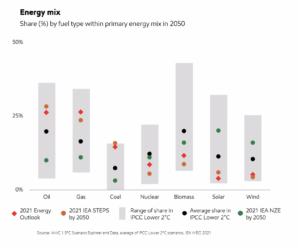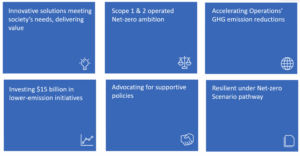ExxonMobil predicts energy demand to increase by 15% between 2022 to 2050 globally, the company’s Europe President Philippe Ducom said at the American Chamber of Commerce in Egypt (AmCham Egypt) oil and gas committee webinar on June 29.
While the energy demand will decrease in developed economies and the demand in emerging economies will increase, the global average will ultimately rise, Ducom highlights.
AmCham Egypt’s oil and gas committee hosted Ducom to discuss “Advancing Climate Solutions: The ExxonMobil Strategy” as part of its international corporate leadership series.
Key highlights
● The demand for ExxonMobil products went down by 20% due to COVID-19.
● Energy demand has been recovering post-COVID-19, but the supply chain is struggling to catch up due to decreased investment in the sector.
● Energy per capita will drop in emerging and developed economies by 2050.
● The industrial sector uses half of the world’s energy output, and it is the hardest sector to decarbonize.
● The energy conglomerate anticipates a 20% increase in demand for energy in the transport sector by 2050. While the demand for duty vehicle energy – like cars – is expected to decrease, the demand for commercial vehicle energy – like trucks, ships, and airplanes – will increase.
With all of these precedents, energy-related carbon dioxide (CO2) emissions will increase and peak by 2030, ExxonMobil’s Europe president said, before declining 13% by 2050.
Global emissions have continued to grow – apart from 2020 due to COVID-19 lockdowns- incentivizing multiple commitments from different countries to reduce their emissions.
The global population and its lifestyle are critical drivers of energy demand. According to the United Nations, the world population will grow from 7.7 billion to almost 9.8 billion between now and 2050, boosting the energy demand.
The goal of the reduced emissions and ultimately net zero is to stabilize the temperature of the Earth to a 1.5 degree Celsius increase.
“The first step is to start to invert the curve, but there is still a very long way to go. Frankly, when you look at the indicators, while we are on track to start seeing a reduction of the emission, we are not on track to meet the objectives of the Paris Agreement,” he highlighted.
The Paris Agreement is a legal commitment by 196 parties to addressing climate change. It was introduced at COP 21 in Paris on December 12, 2015, and enforced on November 4, 2016.
The objective of the Paris Agreement is to limit global warming to 2 degrees Celsius, ideally 1.5 degrees Celsius, once global greenhouse emissions peak to reach climate neutrality by mid-century.
Energy transition pathways
The gray bar shows the demand range and fuel share range by 2050.

The International Energy Agency (IEA) offers a similar scenario called STEPS, which represents actual policies and pledges made by many countries. The IEA scenario prioritizes oil and gas in the future, as well as fast growth, but from a lower basepoint, for the other solutions.
According to Ducom, the Intergovernmental Panel on Climate Change (IPCC), often cited as a reference in the energy transition and climate change field, estimates a significant proportion of traditional fuel usage and faster growth for others.
The IEA also has a net-zero by 2050 scenario, which calls for considerable reductions in oil and gas, coal, and, ultimately, faster growth of environmentally friendly fuels. This scenario necessitates a decrease in global energy demand, which is fundamentally different from the existing dynamic for reaching net-zero by 2050, Ducom cited.
On the road to net-zero by 2050
All of the paths to net-zero rely on some fundamental assumptions. These forecasts translate into varying demands, creating significant uncertainty for organizations in the oil and gas industry about future energy demand.
”There are very different futures out there that will be influenced by the development of technologies, policy decisions, regulatory frameworks, that could lead us to a faster or slow acceleration of certain trends, and for a company like ExxonMobil, and probably many companies in the world, we have to be able to navigate and be successful in all these scenarios,” Ducom said.
ExxonMobil has developed emission reduction roadmaps for each of its massive operating assets to attain net-zero emissions by 2050. 90% of these assets will be completed by the end of 2022, with the remaining 10% ready by the end of 2023.
The company chose its prosperous Permian Basin operations site in Eastern Texas, USA, to demonstrate how to attain net-zero emissions by 2030.
Other highlights of ExxonMobil plans:








